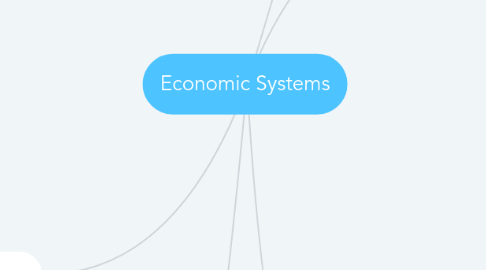
1. Traditional Economy
1.1. Traditional economies depend on agriculture, fishing, hunting, gathering, or some combination of the above. They use barter instead of money.
1.2. A traditional economy is a system that relies on customs, history, and time-honored beliefs
1.2.1. Before the Civil War, the American South was almost entirely a traditional economy. It relied on farming. It used a strong network of traditions and culture to guide it. These were devastated by the war.
1.3. Advantages: There is little friction between members. Custom and tradition dictate the distribution of resources. Everyone knows their contribution toward production, whether it's as a farmer, hunter, or weaver.
1.3.1. Disadvantages: Traditional economies are vulnerable to changes in nature, especially the weather. For this reason, traditional economies limit population growth. When the harvest or hunting is poor, people starve.
2. Command Economy
2.1. A command economy is where a central government makes all economic decisions.
2.2. The government or a collective owns the land and the means of production. It doesn't rely on the laws of supply and demand that operate in a market economy. A command economy also ignores the customs that guide a traditional economy.
2.2.1. Iran is a prime example of a command economy. The government controls 60 percent of the economy through state-owned businesses. It uses price controls and subsidies to regulate the market. This created recessions, which it has ignored. Instead, it devoted resources to expanding its nuclear capability. The United Nations imposed sanctions, worsening its recessions.
2.3. Disadvantages: It's difficult for the central planners to get up-to-date information about consumers' needs. Also, prices are set by the central plan. They no longer measure or control demand. Instead, rationing often becomes necessary. Command economies discourage innovation. They reward business leaders for following directives. This doesn’t allow for taking the risks required to create new solutions. Command economies struggle to produce the right exports at global market prices. It's challenging for central planners to meet the needs of the domestic market.
2.3.1. Advantages: Planned economies can quickly mobilize economic resources on a large scale. They can execute massive projects, create industrial power, and meet social goals. They aren't slowed down by lawsuits from individuals or environmental impact statements. Command economies can wholly transform societies to conform to the government's vision. The new administration nationalizes private companies.
3. Mixed Economy
3.1. A mixed economy is a system that combines characteristics of market, command and traditional economies.
3.2. A mixed economy has three of the following characteristics of a market economy. First, it protects private property. Second, it allows the free market and the laws of supply and demand to determine prices. Third, it is driven by the motivation of the self-interest of individuals.
3.2.1. Advantages: It distributes goods and services to where they are most needed. It allows prices to measure supply and demand. It also rewards the most efficient producers with the highest profit. That means customers get the best value for their dollar. Third, it encourages innovation to meet customer needs more creatively, cheaply or efficiently. A mixed economy also minimizes the disadvantages of a market economy. A market economy could neglect areas like defense, technology, and aerospace. A larger governmental role allows fast mobilization to these priority areas.
3.2.2. Disadvantages: A mixed economy can also take on all the disadvantages of the other types of economies. It just depends on which characteristics the mixed economy emphasizes. The defense industry could become a government-subsidized monopoly or oligarchy system. That could put the country into debt, slowing down economic growth in the long run. Successful businesses can lobby the government for more subsidies and tax breaks. The government could protect the free market so much that it doesn’t regulate enough.
3.3. The United States Constitution established a mixed economy. It protects ownership of private property. It also limits government interference in business operations. That promotes the innovation that's a hallmark of a market economy.
4. Market Economy
4.1. A market economy is a system where the laws of supply and demand direct the production of goods and services.
4.1.1. People living in this type of economy can buy any product they desire as long as they are able to afford it. This requires money, which becomes the key to this type of society. In order to obtain money, individuals must sell something. In this case, selling their time to employers is the most common way to earn money. Goods are distributed to individuals with the most money. Self interest motivates action, suppliers sell at the highest possible price and consumers negotiate the lowest possible price. This self interest provides an accurate reflection of supply and demand, which helps control prices. Additionally, the focus of the suppliers in market economies is on increasing profit rather than ensuring that basic public needs are met.
4.2. Advantages: One of the biggest advantages is that competition drives efficiency. This means that in order to be successful, producers must carefully examine their production processes, reduce costs, and reduce production time. In addition to being efficient, suppliers must also be creative and innovative to keep a competitive edge. This environment also leads to diversity of goods in the marketplace, which give the consumer more choices
4.2.1. Disadvantages: One of the biggest disadvantages of market economies is their reliance on money as the primary measure and means of success. This creates a society of wealthy versus poor individuals. The gap between these two groups continues to widen because in this economy, it is easier for people with money to make more money, excluding people living in poverty from upward mobility. Because the focus is on making profit, suppliers aim to reduce production costs which can lead to environmental damage. It is often more expensive to produce goods in an environmentally sustainable way, therefore, government regulations are required.
